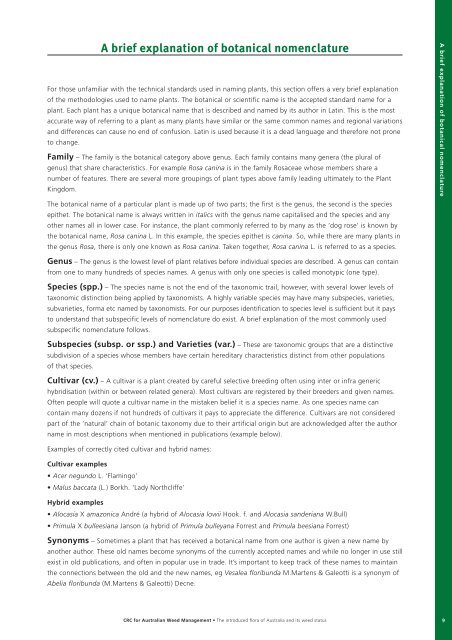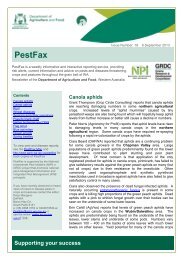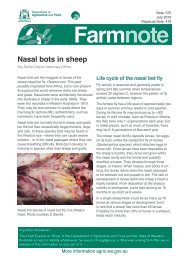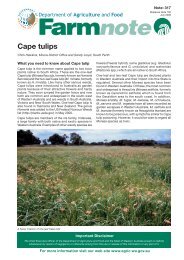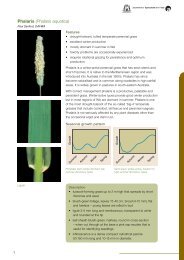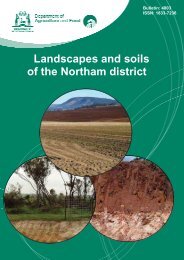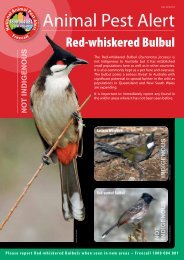- Page 1 and 2: CRC for Australian Weed Management
- Page 3 and 4: Table of contents Foreword 1 Introd
- Page 5 and 6: Foreword Invasive plants are specie
- Page 7 and 8: Introduction Humans are by far the
- Page 9 and 10: Background The introduction of a pl
- Page 11: How to use this book To aid people
- Page 15 and 16: A quick guide to understanding this
- Page 17 and 18: AAbelia chinensis R.Br. Linnaeaceae
- Page 19 and 20: Acacia giraffae Willd. Leguminosae
- Page 21 and 22: Acanthus spinosissimus Pers. Acanth
- Page 23 and 24: Achnatherum calamagrostis (L.) P.Be
- Page 25 and 26: Adenia venenata Forsk. Passiflorace
- Page 27 and 28: Aechmea spectabilis Brongniart ex H
- Page 29 and 30: Aethusa cynapium L. Apiaceae ◆ We
- Page 31 and 32: Agave tequilana F.A.C.Weber Agavace
- Page 33 and 34: Ajuga chamaepitys (L.) Schreb. Lami
- Page 35 and 36: Allium chamaemoly L. Alliaceae - Li
- Page 37 and 38: Alocasia crassifolia Engl. Araceae
- Page 39 and 40: Aloe mudenensis Reynolds Aloeaceae
- Page 41 and 42: Alstroemeria magenta Ehr.Bayer Lili
- Page 43 and 44: Amesiella philippinensis (Ames) Gar
- Page 45 and 46: Andropogon ischaemum L. Poaceae = B
- Page 47 and 48: Angraecum magdalenae Schltr. & Perr
- Page 49 and 50: Anthurium hoffmannii Schott Araceae
- Page 51 and 52: Aquilegia X cultorum Bergmans Ranun
- Page 53 and 54: Arctostaphylos arbutoides (Lindl.)
- Page 55 and 56: Argyrolobium uniflorum (Decne.) Jau
- Page 57 and 58: Aronia melanocarpa (Michx.) Elliott
- Page 59 and 60: Arundinaria amabilis McClure Poacea
- Page 61 and 62: Asparagus densiflorus (Kunth) Jesso
- Page 63 and 64:
Aster filifolius Vent. Asteraceae A
- Page 65 and 66:
Astrophytum coahuilense (H.Moeller)
- Page 67 and 68:
Avena strigosa Schreb. Poaceae ◆
- Page 69 and 70:
BBabiana ambigua (Roem. & Schult.)
- Page 71 and 72:
Baptisia leucantha Torr. & A.Gray L
- Page 73 and 74:
Begonia bradei Irmsch. Begoniaceae
- Page 75 and 76:
Begonia thiemei C.DC. Begoniaceae B
- Page 77 and 78:
Berberis suberecta Ahrendt Berberid
- Page 79 and 80:
Bifora testiculata (L.) Spreng. Api
- Page 81 and 82:
Borago pygmaea (DC.) Chater & Greut
- Page 83 and 84:
Brachyglottis haastii (Hook. f.) B.
- Page 85 and 86:
Brodiaea lactea (Lindl.) S.Watson L
- Page 87 and 88:
Brunfelsia nitida Benth. Solanaceae
- Page 89 and 90:
Bulbophyllum cheiri Lindl. Orchidac
- Page 91 and 92:
CCabomba aquatica Aubl. Cabombaceae
- Page 93 and 94:
Calathea zebrina (Sims) Lindl. Mara
- Page 95 and 96:
Calophyllum antillanum Britton Clus
- Page 97 and 98:
Camellia sasanqua Thunb. Theaceae
- Page 99 and 100:
Canistropsis simulans (E.Pereira &
- Page 101 and 102:
Carex lepidocarpa Tausch Cyperaceae
- Page 103 and 104:
Carya pecan (Marshall) Engl. & Grae
- Page 105 and 106:
Catalpa X hybrida Spath Bignoniacea
- Page 107 and 108:
Cedrus libani A.Rich. Pinaceae See:
- Page 109 and 110:
Centipeda minima (L.) A.Br. & Asch.
- Page 111 and 112:
Cereus amazonicus K.Schum. Cactacea
- Page 113 and 114:
Chamaecrista rotundifolia (Pers.) G
- Page 115 and 116:
Chara fibrosa C.Agardh ex Bruzelius
- Page 117 and 118:
Chloris ventricosa R.Br. Poaceae
- Page 119 and 120:
Cibotium chamissoi Kaulf. Dicksonia
- Page 121 and 122:
Citharexylum spinosum L. Verbenacea
- Page 123 and 124:
Cleistocactus smaragdiflorus (Web.)
- Page 125 and 126:
Clerodendrum myricoides (Hochst.) V
- Page 127 and 128:
Codonopsis bulleyana Forrest ex Die
- Page 129 and 130:
Columnea arguta C.V.Morton Gesneria
- Page 131 and 132:
Convolvulus mauritanicus Boiss. Con
- Page 133 and 134:
Cordyline pumilio Hook. f. Agavacea
- Page 135 and 136:
Corydalis solida (L.) Clairv. Papav
- Page 137 and 138:
Cotoneaster cooperi C.Marquand Rosa
- Page 139 and 140:
Crassula cornuta Schönland & Baker
- Page 141 and 142:
Crataegus saligna Greene Rosaceae
- Page 143 and 144:
Crocus medius Balb. Iridaceae Crocu
- Page 145 and 146:
Cryptocoryne crispatula Engl. Arace
- Page 147 and 148:
Curcuma aromatica Salisb. Zingibera
- Page 149 and 150:
Cylindropuntia alcahes (F.A.C.Weber
- Page 151 and 152:
Cyperus rotundus L. Cyperaceae ◆
- Page 153 and 154:
DDaboecia azorica Tutin & E.F.Warb.
- Page 155 and 156:
Dasiphora fruticosa (L.) Rydb. Rosa
- Page 157 and 158:
Delphinium semibarbatum Bien. ex Bo
- Page 159 and 160:
Dendrobium margaritaceum Finet Orch
- Page 161 and 162:
Desmanthus virgatus (L.) Willd. Leg
- Page 163 and 164:
Dianthus myrtinervius Griseb. Caryo
- Page 165 and 166:
Diervilla fujisanensis Makino Dierv
- Page 167 and 168:
Diospyros dichrophylla (Gand.) De W
- Page 169 and 170:
Discocactus heptacanthus (Barb.Rodr
- Page 171 and 172:
Dorstenia contrajerva L. Moraceae
- Page 173 and 174:
Drosera X californica Cheek Drosera
- Page 175 and 176:
Duvalia pubescens N.E.Br. Asclepiad
- Page 177 and 178:
EEarina autumnalis (G.Forst.) Hook.
- Page 179 and 180:
Echinocereus pectinatus (Scheidw.)
- Page 181 and 182:
Echinopsis candicans (Gillies ex Sa
- Page 183 and 184:
Echinopsis vasquezii (Rausch) G.D.R
- Page 185 and 186:
Eleusine compressa (Forssk.) Asch.
- Page 187 and 188:
Encephalartos transvenosus Stapf &
- Page 189 and 190:
Epilobium canum (Greene) Raven Onag
- Page 191 and 192:
Eragrostis trichophora Cosson & Dur
- Page 193 and 194:
Erica linnaeoides Andr. Ericaceae E
- Page 195 and 196:
Eriosyce curvispina (Bertero ex Col
- Page 197 and 198:
Erythrina parcellii Bull. Leguminos
- Page 199 and 200:
Eucalyptus fastigata H.Deane & Maid
- Page 201 and 202:
Euonymus fortunei (Turcz.) Hand.-Ma
- Page 203 and 204:
Euphorbia lambii Svent. Euphorbiace
- Page 205 and 206:
Euryops chrysanthemoides (DC.) B.No
- Page 207 and 208:
FFabiana densa Remy Solanaceae Fabi
- Page 209 and 210:
Ferocactus tiburonensis (G.E.Linds.
- Page 211 and 212:
Ficus villosa Blume Moraceae ◆ We
- Page 213 and 214:
Frangula purshiana (DC.) J.G.Cooper
- Page 215 and 216:
Fuchsia excorticata (J.R.Forst. & G
- Page 217 and 218:
GGadellia lactiflora (Bieb.) Schulk
- Page 219 and 220:
Garrya flavescens S.Wats. Cornaceae
- Page 221 and 222:
Genista ephedroides DC. Leguminosae
- Page 223 and 224:
Geranium dissectum L. Geraniaceae
- Page 225 and 226:
Gevuina avellana Molina Proteaceae
- Page 227 and 228:
Gladiolus stellatus G.J.Lewis Irida
- Page 229 and 230:
Gnaphalium polycaulon Pers. Asterac
- Page 231 and 232:
Guadua paniculata Munro Poaceae See
- Page 233 and 234:
Gymnocalycium saglione (Cels) Brown
- Page 235 and 236:
HHaageocereus acanthocladus Rauh &
- Page 237 and 238:
Hamamelis mollis Oliv. Hamamelidace
- Page 239 and 240:
Hebe X amabilis (Cheeseman) Cockayn
- Page 241 and 242:
Hedyotis procumbens (Walt. ex J.F.G
- Page 243 and 244:
Heliconia mutisiana Cuatrec. Helico
- Page 245 and 246:
Hermannia hyssopifolia L. Sterculia
- Page 247 and 248:
Hibiscus lasiocarpos Cav. Malvaceae
- Page 249 and 250:
Homoglossum quadrangulare (Burm. f.
- Page 251 and 252:
Hoya dimorpha F.M.Bailey Asclepiada
- Page 253 and 254:
Hoya subcalva Burkill Asclepiadacea
- Page 255 and 256:
Hydrocleys nymphoides (Willd.) Buch
- Page 257 and 258:
Hypericum kouytchense H.Lèv. Clusi
- Page 259 and 260:
IIberis affinis Jord. Brassicaceae
- Page 261 and 262:
Indigofera cordifolia B.Heyne ex Ro
- Page 263 and 264:
Iris bucharica Foster Iridaceae Iri
- Page 265 and 266:
Iris squalens L. Iridaceae = Iris X
- Page 267 and 268:
J Jaborosa integrifolia Lam. Solana
- Page 269 and 270:
Juncus canadensis Gay Juncaceae ◆
- Page 271 and 272:
KKadsura coccinea A.C.Sm. Schisandr
- Page 273 and 274:
Kleinia stapeliiformis (E.Phillips)
- Page 275 and 276:
LLabisia pumila (Blume) Fern.-Vill.
- Page 277 and 278:
Lampranthus aurantiacus (DC.) Schwa
- Page 279 and 280:
Lavandula X allardi Hy. Lamiaceae L
- Page 281 and 282:
Lepidium campestre (L.) R.Br. Brass
- Page 283 and 284:
Leucadendron loranthifolium (Salisb
- Page 285 and 286:
Leymus arenarius (L.) Hochst. Poace
- Page 287 and 288:
Lilium medeoloides A.Gray Liliaceae
- Page 289 and 290:
Linum catharticum L. Linaceae ◆ W
- Page 291 and 292:
Lobelia cardinalis L. Campanulaceae
- Page 293 and 294:
Lonicera korolkowii Stapf Caprifoli
- Page 295 and 296:
Loxogramme lanceolata (Sw.) C.Presl
- Page 297 and 298:
Lycopodium lockyeri D.Jones & B.Gra
- Page 299 and 300:
MMaackia amurensis Rupr. & Maxim. L
- Page 301 and 302:
Mahonia lomariifolia Takeda Berberi
- Page 303 and 304:
Mammillaria aurihamata Boed. Cactac
- Page 305 and 306:
Mammillaria ortizrubiana (Bravo) We
- Page 307 and 308:
Maranta zebrina Sims Marantaceae Ma
- Page 309 and 310:
Maxillaria variabilis Batem. ex Lin
- Page 311 and 312:
Melicytus lanceolatus Hook. f. Viol
- Page 313 and 314:
Mentha basilica Lojac. Lamiaceae Me
- Page 315 and 316:
Michelia skinneriana Dunn Magnoliac
- Page 317 and 318:
Mimulus pictus (Curran ex Greene) G
- Page 319 and 320:
Moraea bipartita L.Bolus Iridaceae
- Page 321 and 322:
Murdannia nudiflora (L.) Brenan Com
- Page 323 and 324:
Myrica phanerodonta Standl. Myricac
- Page 325 and 326:
NNageia falcata (Thunb.) Kuntze Pod
- Page 327 and 328:
Nematanthus fritschii Hoehne Gesner
- Page 329 and 330:
Neoporteria islayensis (Foerster) D
- Page 331 and 332:
Nepenthes veitchii Hook. Nepenthace
- Page 333 and 334:
Nierembergia veitchii Hook. Solanac
- Page 335 and 336:
Notylia barkeri Lindl. Orchidaceae
- Page 337 and 338:
OOberonia anceps Lindl. Orchidaceae
- Page 339 and 340:
Olea africana Mill. Oleaceae = Olea
- Page 341 and 342:
Ophiopogon jaburan (Siebold) G.Lodd
- Page 343 and 344:
Opuntia lasiacantha Pfeiff. Cactace
- Page 345 and 346:
Orania longisquama (Jum.) J.Dransf.
- Page 347 and 348:
Orobanche loricata Recihb. Orobanch
- Page 349 and 350:
Oxalis herrerae R.Knuth Oxalidaceae
- Page 351 and 352:
PPabstia jugosa (Lindl.) Garay Orch
- Page 353 and 354:
Panicum bulbosum Kunth Poaceae ◆
- Page 355 and 356:
Paphiopedilum superbiens (Rchb. f.)
- Page 357 and 358:
Parodia mueller-melchersii (Backeb.
- Page 359 and 360:
Passiflora ciliata Aiton Passiflora
- Page 361 and 362:
Pelargonium fragrans Willd. Gerania
- Page 363 and 364:
Penstemon azureus Benth. Scrophular
- Page 365 and 366:
Pereskia sacharosa Griseb. Cactacea
- Page 367 and 368:
Phalaenopsis amboinensis J.J.Sm. Or
- Page 369 and 370:
Philodendron cordatum hort. Araceae
- Page 371 and 372:
Phormium colensoi Hook. f. Agavacea
- Page 373 and 374:
Physalis micrantha Link Solanaceae
- Page 375 and 376:
Pilosocereus azureus F.Ritter Cacta
- Page 377 and 378:
Pinus banksiana Lamb. Pinaceae ◆
- Page 379 and 380:
Pistacia mutica Fisch. & C.A.Mey. A
- Page 381 and 382:
Platanus X acerifolia (Aiton) Willd
- Page 383 and 384:
Pleurocalyptus pancheri (Brongn. &
- Page 385 and 386:
Polemonium foliosissimum A.Gray Pol
- Page 387 and 388:
Polypodium pappei Mett Polypodiacea
- Page 389 and 390:
Populus yunnanensis Dode Salicaceae
- Page 391 and 392:
Primula X bulleesiana Janson. Primu
- Page 393 and 394:
Prosopis spicigera L. Leguminosae -
- Page 395 and 396:
Prunus lusitanica L. Rosaceae ◆ W
- Page 397 and 398:
Pseudovigna argentea (Willd.) Verdc
- Page 399 and 400:
Ptychosperma ledermaniana (Becc.) M
- Page 401 and 402:
Pyrus cossonii Rehder Rosaceae Pyru
- Page 403 and 404:
Q Qiongzhuea tumidinoda C.J.Hsueh &
- Page 405 and 406:
Quercus shumardii Buckley Fagaceae
- Page 407 and 408:
RRabiea albinota (Haw.) N.E.Br. & N
- Page 409 and 410:
Rebutia einsteinii Fri ex Kreuz. &
- Page 411 and 412:
Rhapidophyllum hystrix (Pursh) H.We
- Page 413 and 414:
Rhodanthemum hosmariense (Ball) B.H
- Page 415 and 416:
Rhododendron forrestii Balf. f. ex
- Page 417 and 418:
Rhododendron oreotrephes W.W.Sm. Er
- Page 419 and 420:
Rhombophyllum dolabriforme Schwante
- Page 421 and 422:
Robinia fertilis Ashe Leguminosae -
- Page 423 and 424:
Rosa blanda Aiton Rosaceae ◆ Weed
- Page 425 and 426:
Rosmarinus angustifolius Mill. Lami
- Page 427 and 428:
Ruellia barbillana Cufod. Acanthace
- Page 429 and 430:
SSabal bermudana L.H.Bailey Arecace
- Page 431 and 432:
Salix helvetica Vill. Salicaceae Sa
- Page 433 and 434:
Salvia ianthina Otto & Dietr. Lamia
- Page 435 and 436:
Sanguinaria canadensis L. Papaverac
- Page 437 and 438:
Sarracenia purpurea L. X Sarracenia
- Page 439 and 440:
Scadoxus cinnabarinus (Decne.) Frii
- Page 441 and 442:
Schoenorchis densiflora Schltr. Orc
- Page 443 and 444:
Scorzonera hispanica L. Asteraceae
- Page 445 and 446:
Sedum ternatum Michx. Crassulaceae
- Page 447 and 448:
Senecio hybridus (Willd.) Regel Ast
- Page 449 and 450:
Sesbania bispinosa (Jacq.) W.Wight
- Page 451 and 452:
Silene bourgaei Webb ex Christ Cary
- Page 453 and 454:
Sisyrinchium littorale Greene Irida
- Page 455 and 456:
Solanum pimpinellifolium Jusl. Sola
- Page 457 and 458:
Sorbaria grandiflora (Sweet) Maxim.
- Page 459 and 460:
Spergularia maritima (All.) Chiov.
- Page 461 and 462:
Spiranthes spiralis (L.) Chevall. O
- Page 463 and 464:
Statice sinuata L. Plumbaginaceae =
- Page 465 and 466:
Stipa fontanesii Parl. Poaceae Stip
- Page 467 and 468:
Styrax officinalis L. Styracaceae S
- Page 469 and 470:
Syngonium erythrophyllum Birdsey ex
- Page 471 and 472:
TTabebuia alba (Cham.) Sandwith Big
- Page 473 and 474:
Tapeinia magellanica J.F.Gmel. Irid
- Page 475 and 476:
Tetragonolobus maritimus (L.) Roth
- Page 477 and 478:
Themeda avenacea (F.Müell.) Maiden
- Page 479 and 480:
Thymus villosus L. Lamiaceae Thymus
- Page 481 and 482:
Tillandsia kurt-horstii Rauh Bromel
- Page 483 and 484:
Tradescantia blossfeldiana Mildbr.
- Page 485 and 486:
Tridentea peculiaris (Lückh.) L.C.
- Page 487 and 488:
Trifolium tembense Fresen. Legumino
- Page 489 and 490:
Triumfetta rhomboidea Jacq. Tiliace
- Page 491 and 492:
Turbinicarpus valdezianus (H.Moller
- Page 493 and 494:
UUebelmannia buiningii Donald Cacta
- Page 495 and 496:
Utricularia inflata Walter Lentibul
- Page 497 and 498:
VVaccaria hispanica (Mill.) Rausche
- Page 499 and 500:
Vepris undulata Comm. Rutaceae Vera
- Page 501 and 502:
Veronica scutellata L. Scrophularia
- Page 503 and 504:
Vigna angularis (Willd.) Ohwi & H.O
- Page 505 and 506:
Vitis rupestris Scheele Vitaceae
- Page 507 and 508:
WWachendorfia brachyandra W.F.Barke
- Page 509 and 510:
Whipplea modesta Torr. Hydrangeacea
- Page 511 and 512:
XXantheranthemum igneum (Linden) Li
- Page 513 and 514:
YYpsilopus longifolia (Kraenzl.) Su
- Page 515 and 516:
ZZalacca edulis Reinw. Arecaceae Za
- Page 517 and 518:
Zornia glochidiata Rchb. ex DC. Leg
- Page 519 and 520:
Bibliography and notes Agence Médi
- Page 521 and 522:
Botha, C. (2001). Common Weeds of C
- Page 523 and 524:
Haysom, K.A. and Murphy, S.T. (2003
- Page 525 and 526:
Muller, S. (coord.) (2004). Plantes
- Page 527 and 528:
State Herbarium (1998). The Exotic


